growing cocoa in Peru
As much as we enjoyed the Chocolate Salon in Lima, Peru, our journey of chocolate discovery was not to end there. We had been booked on a flight to take us to Tingo Maria, located in Huanuco Province, and also to Tocache, located in the southern part of San Martin Province.
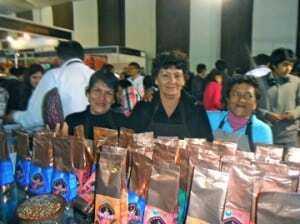
These Peruvian ladies from Santa Rosa are proud of the products they are now producing. Charita is on the left.
We had been in the northern part of San Martin province last year when we visited Tarapoto and the cocoa farmers of Santa Rosa. How surprising it was to see these ladies whom I had met last year when they welcomed us to their farm. Those of you who already have a copy of Chocolatour will recognize Charita on page 16 in the first volume of the book. Charita and fellow members of the Santa Rosa Cooperative are now making a cocoa drink mixed with various flavourings such as wheat, packaging it, and selling it via shows such as the Salón del Cacao Y Chocolate in Lima and other local markets.
My 2013 trip was as part of an international delegation of people involved in the chocolate industry who were invited by PromPeru and USAID (the US Agency for International Development) to visit Peru and learn more about its fledgling cocoa industry. I had heard mention of USAID on my visit to Peru in 2012, but the trip this year reinforced just how important this agency has been in helping Peru rise like a phoenix from the smouldering ashes of the coca industry and reinvent itself as an integral player in the cocoa industry. Peru now grows some of the finest aromatic cocoa in the world, and is determined to make sure the world knows about it. I didn’t need anyone to convince me that Peruvian cocoa makes great chocolate. I learned that last year, when I tasted the chocolate of Orquidea, Roselen, Xocolatl, and others, and knew it was something special.
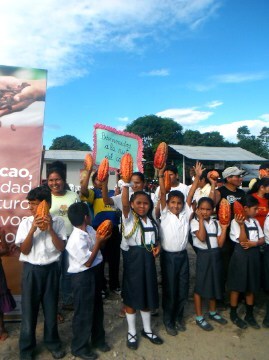
Our welcoming committee in Tocache, Peru included a visit from a group of school students who presented us with cocoa pods.
On my second cocoa trip to Peru, we visited the cocoa growing regions of Tocache and Tingo Maria as key stops along the Ruta del Cacao (Cocoa Route) and were welcomed with great enthusiasm as we learned the intricacies of growing cacao in this part of Peru. It was a fascinating journey, and provided me with more great information for the second volume of Chocolatour and this blog.
We visited several cocoa farms and saw the pride from each of the farmers as they described their growing process and how the harvest is a family and community affair. We met many passionate people who want the world to learn of the quality of their delicious aromatic cocoa.
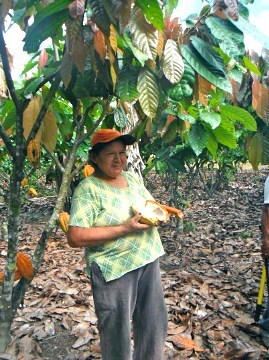
Peruvian cocoa farmer showing us the inside of the cocoa pod.
And as in every region I have visited, the cocoa farmers in this region had their own unique challenges. I was surprised to see so many miniature black pods on the cacao trees, and when I asked what they represented, I was told that these were aborted pods. The tree senses how many pods it can nurture to maturation, and aborts the rest. So you will see these tiny black pods on the trees that will just fall off and decompose onto the ground.
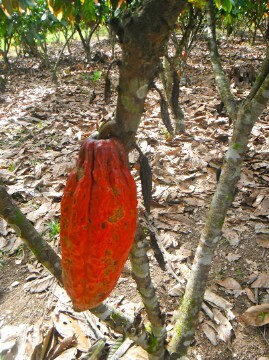
The mini black pop on the right is an abortion.
It was so fascinating learning more about cacao growing in Peru. It is such a challenge for the cocoa farmers, but with tenacity and continuing education, they are learning how to make the best of it. Though slightly acidic, the result is magnificent Peruvian chocolate that is among the finest fruity chocolate in the world.
Have you tasted Peruvian chocolate, or chocolate made with Peruvian cacao that has been exported to other chocolate makers around the world?
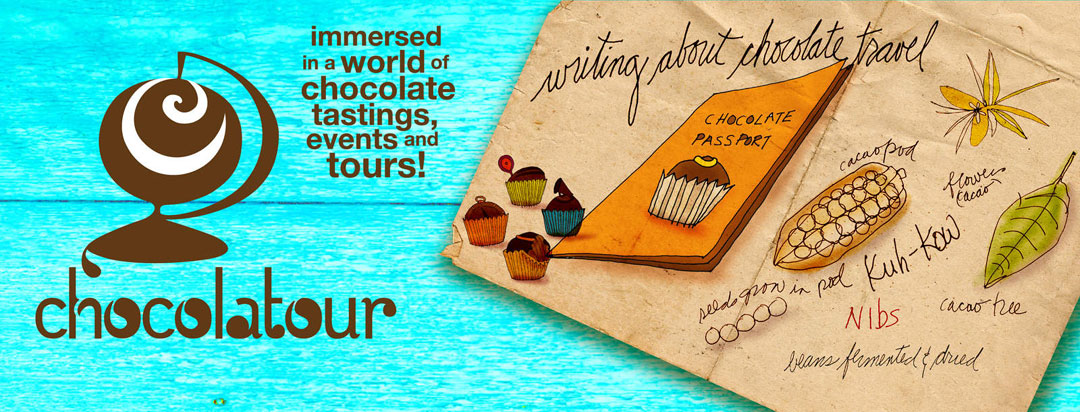








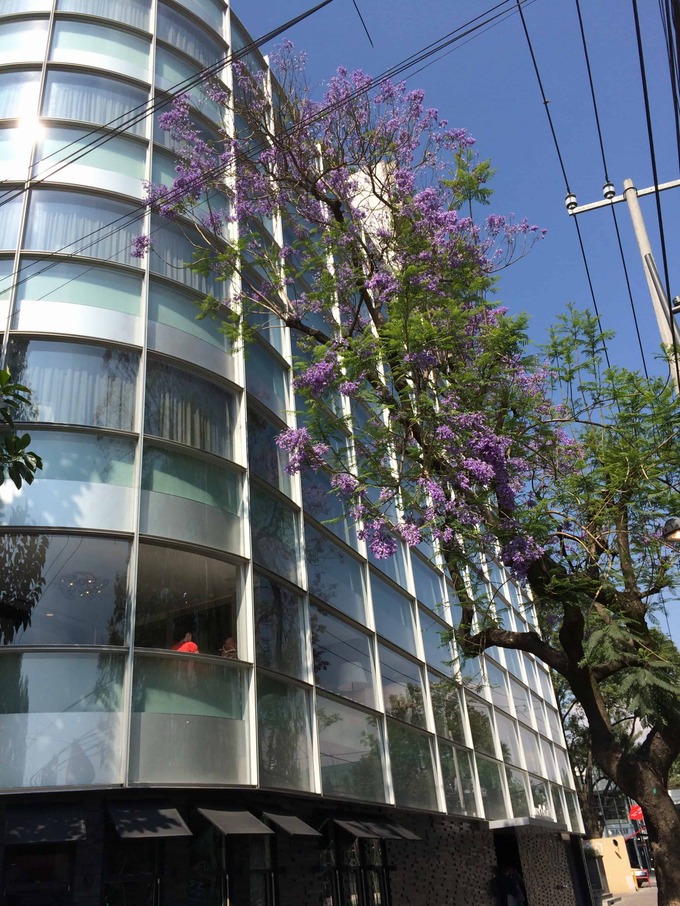

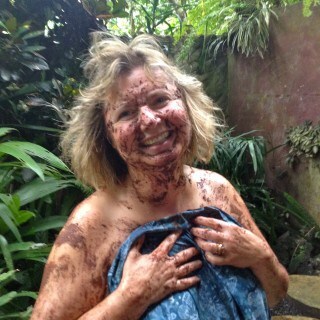
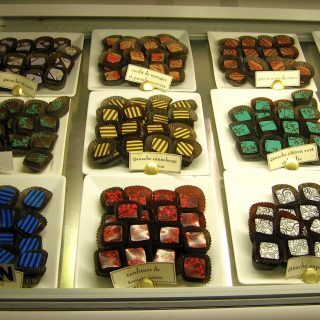

So wonderful to read about Peru’s economic transformation! Chocolate is the gift that keeps on giving!
Hi Katherine, and Thx for visiting the blog.
Yes, it’s wonderful how the Peruvian farmers have made the transition from growing coca to cacao (cocoa). All withe the help of USAid. They’ve been remarkable in giving the farmers the training and support needed to make the transition.
Chocolate comes from trees. It is amazing how they take fruit from the tree and make so many different things out of them.
Your trip looks fun. Reminds me of a similar travel I had a few months ago. I had fun walking around the cocoa farm.
Hi Doreen! Your blog is really interesting and insightful. Waiting for the Peruvian Chocolate Adventures Part II 🙂
Thanks so much, Elis. It’s nice to make contact with you. I hope you’ll subscribe to the blog. We’ve got lots more Chocolatouring to do!
There were posts about Peru from my trip there last year as well. I’ll write more about this year’s trip in a couple of weeks. This week, I’ve got a special announcement to make!
I never even realized where chocolate came from until your blog. How intresting! Im a choco-holic. Got to have some daily. I guess that’s why Im 44 and 24 lbs overweight.
Hi, Tammy. It is exactly for people like you that I write this blog, and have written my book.
My goal is to educate chocolate lovers about the world of chocolate in a fun and passionate way. And to get you to move away from eating piles of commercial chocolate candy, to just eating just one square per day of pure, high quality chocolate. It’s better for your health, and it tastes a whole lot better. 🙂
Jungles are full of surprises. Scientists are still discovering new plants and animal most everyday. Jungles usually get a lot of rain so these exotic things can exist.
So true! I know that new varietals of cacao are being discovered all the time! It’s really cool that there are still yet-to-be-discovered species in the world.
You surely must have had a great time. It must be good to witness all this so closely. Thanks for sharing your experience with us 🙂
Thanks, Veronica. I’m glad you’re enjoying the journeys with me. 🙂
Hi Virginia: Yes, I certainly missed having you on this 2nd Chocolatour to Peru. Maybe next year, as there is a possibility I may have the opportunity to see the cacao grown in the Cusco area, It is highly regarded.
To my knowledge, the CCN51 is only grown in Peru, and because almost/all of it is grown organically, no commercial fertilizers are used to enhance the soil or the crop. We didn’t see any aborted pods in Santa Rosa, but maybe that is because they haven’t been growing cacao on their land as long as the farmers have in Tocache.
Hi Doreen:
Feeling nostalgic after reading your post.
I’d like to know more about the difference between the hybrids and native varieties in terms of taste, yield, nutritional value etc. Brian makes an interesting point about access to fertilizers. Is CCN 51 common in other cacao-growing regions besides Peru/Ecuador?
Thanks for your comments, Salika, Marytlou, and Anushha. Yes, it really is quite fascinating to visit a cocoa plantation and see how and where our beloved chocolate comes from. But if you can’t go there (to Peru and other growing regions), I’m happy to share info here, and in more detail in my book Chocolatour, which you can purchase at chocolatour.net. Thanks for joining our growing community.
It’s fascinating how the tree can sense how many it can nurture to maturation.
A nice post about nature and the chocolaty experience. I aspire to witness such a trip. Thanks for the share.
The nature has its own charm, this is what I can conclude from this post, Doreen. Thanks for sharing it, I found this post very close to my heart.
Hi From Cajamarca Doreen. The black aborted pods are typically a symptom of high yield hybrid cacao varieties being grown in standard or sub-standard soil by farmers without access to fertilizers. when you come have heirloom or native varieties they tend to grow without the need for fertilizers because they evolved in that soil and climate. they yield around 300 – 500kg per Ha per year. Modern hybrids like the CCN 51 those kids are holding up can produce up to 2000kg per year, but without fertilizers they put the soil out of balance in about 5-7 years and begin to exhibit the aborted pod syndrome you were seeing.
saludos – brian
Thanks so much for your comment, Brian! It was great seeing you in Lima, and great to hear your perspective here on the blog. I know that you know a tremendous amount about the growing of cacao. Hope to see you again next year. 🙂
Great news that Peruvian farmers are moving from coca to cocoa. It will benefit the world, at least a tini wini bit. Besides I’m confident the farmers are much happier growing cocoa than coca.
They are indeed, happier, Catarina, and safer! We heard many stories of how the violence of the drug trade used to terrorize the local communities. Chocolate really DOES make the world a better place. 🙂
Doreen – It is wonderful how each of these farmers so much pride in their crops. Without farmers where would we be? Mother nature plays a big part in agriculture as you mentioned this tree will abort the pods that will not produce. Nature never stops amazing me.
Hi Elizabeth and thanks for the comment. Yes, you’ll find that most farmers you meet take great pride in what they do. It’s really fantastic to see that, as most farmers certainly aren’t in it for the $$!
The resilience and ingenuity of the people of Peru to refocus their activities and change their harvest to cocoa from coca is pretty amazing. I hope their fledging industry grows well. You learn so many interesting things on your travels, not surprised that you are working on volume two.
Hi Debra and thanks for your comment. Yes, I’ve really been amazed by the Peruvian people. They are friendly, hospitable, hard-working and creative. They have really given me inspiration to celebrate the growing of cacao. There will be more coverage on Peru in volume II of Chocolatour.
That is so fascinating about the trees and growing pods. Mother nature is pretty darned smart. It reminds of squirrels. They have a similar way of keeping their numbers in check, but I won’t go in to detail here. I just think it’s interesting.
Hi Cheryl and thanks for your comment. Yes, I really found the abundance of aborted pods to be fascinating. I hadn’t seen that in any of the other growing regions I have visited.
You must have been charmed by the school kids that greeted you. That was really interesting about the black pods. Mother Nature is a wondrous thing, isn’t it? How the tree knows that is fascinating to me. Seeing all of this first hand has to be a joy for you. 🙂
Hi Susan:
Yes, having those children come out to greet us was really a highlight. The village of Tocache sure know how to throw a welcome party!
Fascinating! Like kangaroos and (I think) rabbits, the trees won’t support what’s not sustainable.
I’m about 1/4 the way through Choclatour Vol. I. Finding it interesting, informative and well-written. Had to go look up more info on stearic acid and oleic acid, pertaining to your comments on diabetes. Right on! Most helpful. Looking forward to the rest of the book, and the series.
LL
Thanks so much for your words of support, Linda. I’m glad you’re enjoying the book. And I’m glad you’re finding my info pertaining to diabetics eating chocolate to be accurate. It was your response to one of my earlier posts that sparked that research and inclusion in the Health Benefits chapter of Chocolatour.